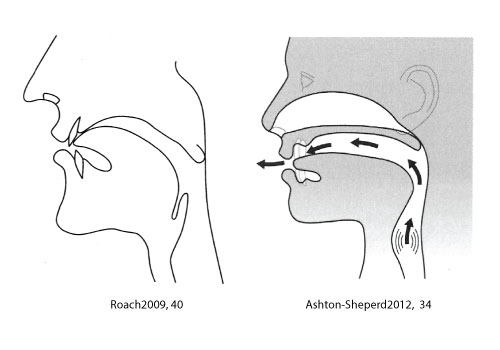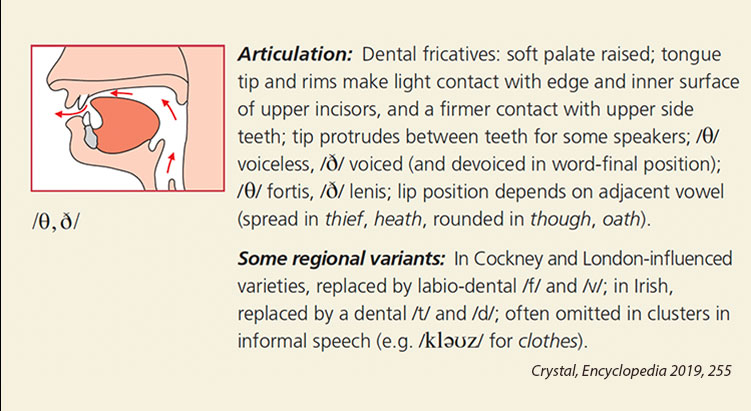The English “th,” the dread of so many ESL and EFL learners. Tricky to learn and to teach as it means pronouncing sounds unused in many languages.
It is possible to speak English correctly without mastering the pronunciation of the “th.” Some specialists do not consider teaching it a priority (famously so Jenkins 2000 and 2002). Yet, mastering the “th” is often a request from the learners themselves, not only to sound more “native” but also to feel more confident about their overall pronunciation. Additionally, since the “th” is quite frequent in English, its repeated mispronunciation may be irritating to many people. Finally, in some cases, this can also lead to misunderstandings. One thinks of examples like fin-sin-thin, tick-thick-sick, or thinking-sinking as in this famous Berlitz commercial.
So, how do I teach the English “th”?
Two Letters, Three Sounds
First, I make a distinction between the letters “th” and their pronunciation. You often hear or read about “the pronunciation of the th sound.” This is a misnomer. “Th” is not a sound, but a cluster of two letters that are pronounced in different ways. This may sound trivial, but it has pedagogical consequences.
Second, I do tell my students that “th” is not pronounced in two ways as is generally said, but in three: /t/ as in “Thames, Thyme”; /θ/ as in “think, mouth”; and /ð/ as in “this, mother,” at least overall in the UK and the USA. Granted, very few words use the /t/ pronunciation, but there is no reason to skip it altogether. I have had students confused when they heard a /t/ in “Thames or Thailand,” convinced as they were that their only two choices where /θ/ or /ð/.
The Dental /t/
This is the easiest one to teach, albeit the least common. In this case “th” is simply a regular dental /t/. But remember that the /t/ is not pronounced with the tongue positioned exactly the same way in all languages. Depending on their L1, some learners might therefore need a little help with this sound too.
Generally, “th” is pronounced /t/ in some proper nouns and a few other words such as “Thailand, Thames, Theresa, Thomas, Thyme, Esther, etc.” Beware, though, not all proper nouns beginning with “th” use the /t/ pronunciation. For example, in “Théoden, Thatcher, Thea, Thelma, Matthew, Beth” the “th” is pronounced /θ/. There are unfortunately no rules to know when “th” is pronounced /t/.
The fricatives /θ, ð/
The other two pronunciations are much more common and are the ones dreaded by many learners. Again, there are no simple rules to decide which one to use but usage shows patterns. For example, many function words like “the, this, these, that” use /ð/. The voiced /ð/ is also more common in the middle of words, while /θ/ is generally more common in the beginning or at the end. The endings “-the” in verbs (“bathe, breathe”) and “-ther” in nouns (“brother, mother”) are usually pronounced with /ð/.
One reason for the difficulty some have in saying /θ/ and /ð/ is their proximity with similar sounds in their language (/s, z, d, t/, etc.), which is a possible source of confusion. Another reason is that few languages use these fricatives. They are found in Arabic, Greek, Spanish (mostly θ but there are many contexts where ð or a very similar sound is used, see Gómez González 176, 191–192), and a few others, even if they are not always pronounced in exactly the same manner.
Of course, given the worldwide use of English and for various reasons, not all native English speakers pronounce “th” as fricatives, not even in the USA and the UK.
Dentals or Interdentals?
Once you start digging for information on /ð-θ/, things get confusing, and this has consequences on how you learn and teach them. It may be a surprise to many people, but there are three approaches to /ð-θ/: they are either classified as dentals, interdentals, or … both.

Interdental fricatives
The sounds /ð-θ/ are often said to be interdentals, that is, pronounced with the tongue sticking out between the teeth, even if ever so slightly (ex. Ashton-Shepherd 34-35, Avery-Ehrlich 24, Baker, 151, 155, Pennington 93, 149). It is the pronunciation in the picture above right and the one often taught by teachers and countless videos on YouTube. How far the tongue gets out varies widely. Learners are often told to exaggerate sticking their tongue out just to get used to this unusual position. This is the de facto option dreaded by so many. But it does not have to be so.
Dental fricatives
If many people take /ð-θ/ to be interdentals, this is not the approach commonly recommended in most standard works on English pronunciation. They are usually said to be dentals, not interdentals, i.e. pronounced not with the tongue sticking out between the teeth but staying inside the mouth close to the ridge of the upper teeth. You can see this in Roach’s illustration and in the picture of Crystal’s Encyclopedia illustrating this article (so, among many, Celce-Murcia 57, 61, Gómez González 188–189, IPA Handbook ix, 41, Jones 9, Saussure 73, Underhill 39). It is sometimes said that the interdental pronunciation, at least of /θ/, is more American. But even that is not clear since Celce-Murcia (dental) is based on American pronunciation and Ashton-Shepherd (interdental) on RP pronunciation.
It is indeed possible to speak English and keep your tongue inside your mouth most of the time. If you look, for example, at this interview of Adriene Mishler, the YouTube guru of yoga, she keeps her tongue inside her mouth at all times except at 1’52” (don’t ask me why I picked this video. For whatever reason it was suggested to me by YouTube and I don’t even do yoga, though maybe I should).
If you look carefully, you will see that many promoters of the interdental pronunciation actually switch to a dental or close to a dental position when speaking at normal speed. It’s just not easy to speak at a regular speed and stick your mouth out all the time!
Or both
Some authors, recognizing the existence of both pronunciations, use both terminologies or at least signal that both pronunciations may be found (Crystal 516, Celce Murcia 58 n 4, 82, García González 66,Passy 85, Watblet 21, ).
This hesitation between dental or interdental is not found in English only. In Spanish, for example, the Dictionary of the Royal Academy of Spanish consistently presents /θ/ as interdental (but with very little sticking out) but signals that there are variants (RAE 5.2 and 7.1b, see also Hualde 33).
How I do it
Does all this matter at all? Whether we consider /ð-θ/ to be dentals or interdentals, the fact is that both pronunciations are found, though I would venture to say that the dental position is much more widespread in normal speech. As long as you don’t stick the tongue out too much, there is actually not much difference in the outcome of both pronunciations.
- First thing I do is to demystify these sounds. Since, as said before, they are close to other sounds that exist in many languages /ð-θ/ are actually not very hard to pronounce. I never tell my students that these are hard to learn and just go about them like I do for any other sounds. Given the chance to work individually with people if necessary, I rarely have problems teaching /ð-θ/. The sounds /r/ and /l/ are oftentimes harder for students to master.
- If my students speak continental Spanish, Arabic or Greek, the difficulty more or less evaporates. Whether they use the dental or interdental variants, I make them realize that they already have those sounds (or one of them) in their languages and just need to keep on using them in English, even if sometimes with a slight adjustement. So, check first if your students use these fricatives in their language. If they do, problem mostly solved for you and for them.
- I show my students pictures of the phonation involved, similar to the one at the top of this article. If necessary, I show them pictures of similar sounds they can start from (/d, t, s, z, etc./) and go from there different ways depending on their L1 and difficulties.
- As to the learners whose L1 does not have these fricatives, i.e. the majority, and have not acquired the interdental pronunciation, I do not teach the “sticking out the tongue” method. Teaching the dental position avoids the common psychological issue of feeling foolish. People don’t like hanging their tongues out. I have had students actually put their hand in front of their mouth when trying to say /ð-θ/. Furthermore, it is often easier for learners to move from /f, v, s, z, t, d/, common in many languages, to the quite close dentals /ð-θ/ in place and manner of articulation. This is usually far easier than using the interdentals. That said, if some find it more convenient to lower the tongue a little and use the interdental position, that’s fine with me, but I encourage them not to stick the tongue out too much.
- The most important advice I give to my students is that they must not look at the writing “th” but at /ð-θ/. They absolutely must stop trying to utter a /t/ followed by a fricative. Once they pronounce a /t/, an occlusive sound, it becomes impossible to pronounce a fricative in the same emission.
- Though I do give some exercises with words and tongue twisters to repeat, I prefer to use texts and sentences either from the textbooks I use or, better, from “real life“ material. At the beginning, exercises with family relationships (brother, mother, father,etc.) and ordinals (third, fourth, etc.) also provide good communicative opportunities for practice (see Celce-Murcia 74). Encouraging them to learn songs, rhymes, poetry, etc. works well too.
As to more practical exercises and how you actually pronounce these sounds and help the learners do it, that’s the subject of the article on How to pronounce the “th” without sticking your tongue out.
References
Ashton, Helen, and Sarah Shepherd. Work on Your Accent: Clearer Pronunciation for Better Pronunciation. Glasgow: Collins, 2012.
Avery, Peter, and Susan Ehrlich. Teaching American English Pronunciation. Oxford: Oxford University Press, 1992.
Baker, Ann. Ship or Sheep: An Intermediate Pronunciation Course. 3rd ed. Cambridge: CUP, 2006.
Celce-Murcia, Marianne, Donna Brinton, and Janet M. Goodwin. Teaching Pronunciation: a Course Book and Reference Guide. Second edition. Cambridge: CUP, 2010.
Crystal, David. The Cambridge Encyclopedia of the English Language. Cambridge: CUP, 2019.
Gómez González, María de los Ángeles, and Teresa Sánchez Roura. English Pronunciation for Speakers of Spanish: From Theory to Practice. Berlin: De Gruyter Mouton, 2016.
Gutiérrez Ordóñez, Salvador, ed. Real Academia Española, Nueva gramática de la lengua española. Morfología y Sintaxis I. Asociación de academias de la lengua española, 2009.
Hualde, José Ignacio. Los sonidos del español. CUP, Cambridge 2018.
Jones, Daniel. The Pronunciation of English. Cambridge: CUP, 1909.
Mesthrie, R., & Bhatt, R. World Englishes: The Study of New Linguistic Varieties. Cambridge: CUP. 2008.
Jenkins, Jennifer. “A Sociolinguistically Based, Empirically Researched Pronunciation Syllabus for English as an International Language.” Applied Linguistics 23 (1) (2002): 83–103.
Jenkins, Jennifer. The phonology of English as an international language: new models, new norms, new goals. Oxford: Oxford University Press, 2000.
Passy, Paul. Petite phonétique comparée des principales langues européennes. Leipsic, Berlin: Teubner, 1906.
Pennington, Martha C., and Rogerson-Revell, Pamela. English Pronunciation Teaching and Research: Contemporary Perspectives. London: Palgrave Mac Millan, 2019.
Roach, Peter. English Phonetics and Phonology: a Practical Course. Cambridge: CUP, 2009.
Saussure, Ferdinand de. Cours de linguistique générale. Paris: Payot, 1995.
Underhill, Adrian. Sound Foundations: Learning and teaching pronunciation. Oxford: Macmillan, 2005.
Watbled, Jean-Philippe. La prononciation de l’anglais. Paris: Armand Colin, 2006.: Macmillan, 2005.
